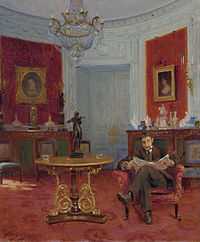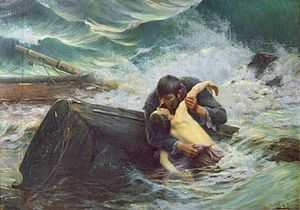Alfred Guillou

Alfred Guillou (12 September 1844, Concarneau - 1926, Concarneau) was a French painter of Breton heritage.
Biography
His father was a fisherman and farmer who served as mayor of Concarneau for fifteen years.[1] He received his first art lessons from the lithographer Théodore Le Monnier (1815–1888), who was visiting Concarneau. On his advice, Guillou moved to Paris in 1862, where he attended the Académie Suisse for a short time, then found a position in the workshop of Alexandre Cabanel.[1] While there, he met Jules Bastien-Lepage, Fernand Cormon and Théophile Deyrolle, who he convinced to give up architecture and join him at Cabanel's.
He debuted at the Salon in 1868 with his Young Breton Fisherman. Three years later, he and his friend Deyrolle left Paris for Concarneau, with nothing more than they could carry on their backs. The following year, Deyrolle married Guillou's sister Suzanne. Together, they created the Concarneau Art Colony, which benefitted from its proximity to Pont-Aven, where Paul Gauguin and his followers congregated.

After his marriage to the daughter of the engraver Joseph Gabriel Tourny (1817–1880), he maintained a home in Montparnasse, but spent as much time as possible in his hometown. Following his father's death in 1887, he built a home and workshop there, became involved in local politics and joined the board of the Musée des beaux-arts de Quimper.[1]
Over the years, the Colony attracted many artists who were either interested in maritime subjects or wanted to achieve a sort of primitivism; represented for them by the traditions of the Breton people, which had survived mostly intact from an earlier period. Among the better-known artists who spent time there were Peder Severin Krøyer, Charles Cottet, Jules Bastien-Lepage, Pascal Dagnan-Bouveret, Amélie Helga Lundahl, Cecilia Beaux and T. Alexander Harrison.
References
External links
| Wikimedia Commons has media related to Alfred Guillou. |
- The Concarneau Art Colony. From Rural Artists' Colonies in Europe, 1870–1910, by Nina Lübbren @ Google Books
- Concarneau et Ses Peintres: Brief biography of Guillou with more paintings, including a portrait of him by Théophile Deyrolle.
- ArtNet: More works by Guillou